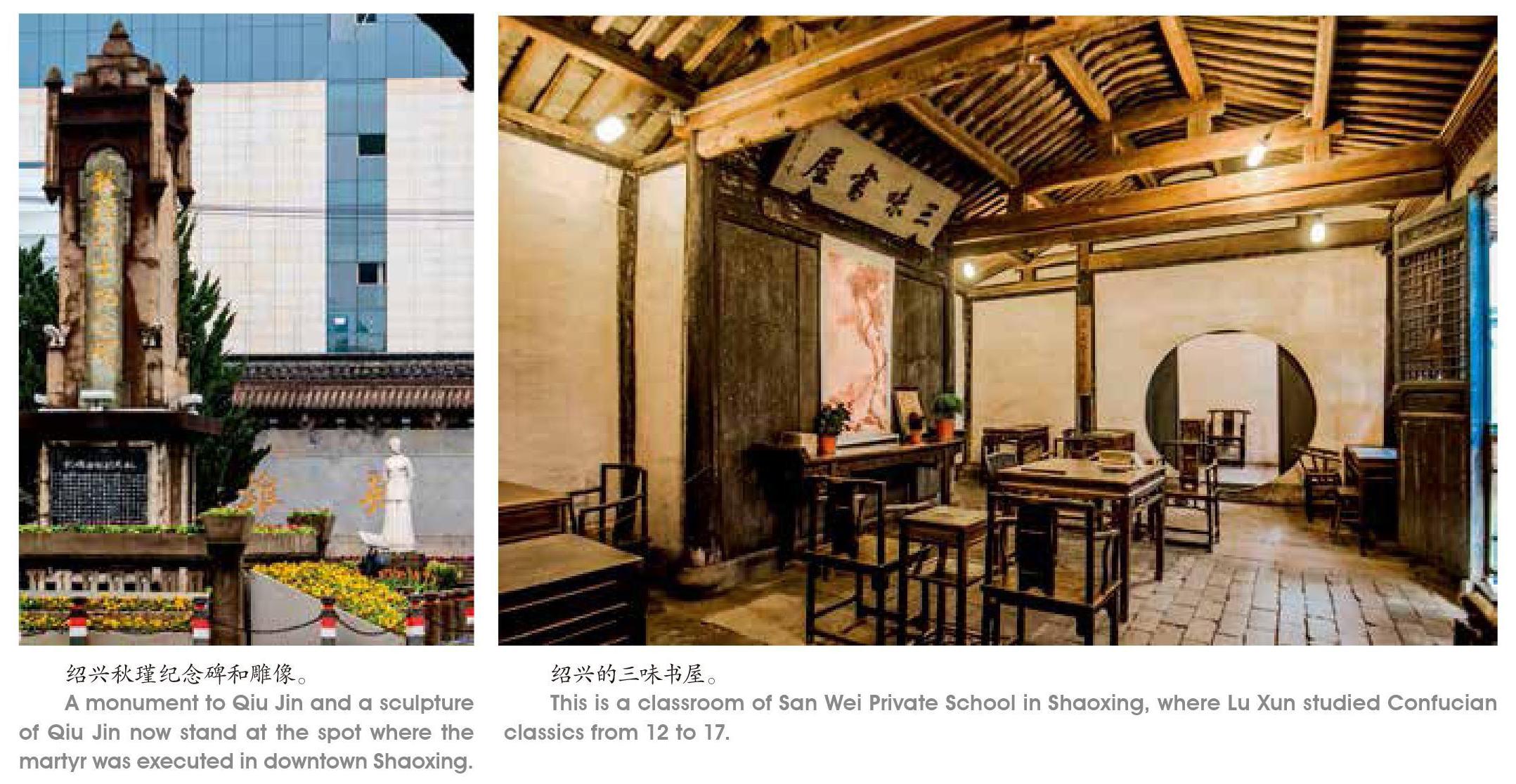剑与箫:“江南”文化精神二重奏
2019-12-13梅新林
梅新林

1904年,蔡元培在上海发起成立光复会,并任会长,以“光复汉族,还我山河,以身许国,功成身退”为宗旨,同时亲自参与研制炸弹等武器,彰显了被后世称为“学界泰斗、人世楷模”的大教育家勇烈的一面。这应归因于晚清特定时代风云的激励,但也同样可以隐约听到春秋时代越王勾践卧薪尝胆精神的远古回响,由此可见文化精神穿越时空的巨大能量。
亦剑亦箫:
江南文化精神的意象提炼
追本溯源,孕育和兴盛于长三角地区的江南文化,主要是由先秦吴越文化所奠定的。春秋后期,越王勾践与吴王阖闾、夫差父子通过相互征战,分别确立了吴越文化的两大支系,同时也是长期影响后代江南文化的两大渊源。然而由于吴越远离中原文化中心,普遍崇尚“断发文身”之习俗,具有好剑尚武之精神。而后至东晋建都建康,终于通过南北文化的深度融合,而实现了由武而文、由刚而柔的历史性转变。但是这种好剑尚武之精神不仅没有真正消失,而且会在重大历史转折中出现周期性的爆发,于是形成了“武——文”“刚——柔”的二重变奏。
由江南文化精神“武——文”
“刚——柔”的二重变奏,不禁联想到反复重现于近代江南名士、启蒙思想家龚自珍诗中的“剑——箫”这对核心意象,其中最为典型的是作于清代道光三年(1823)的《漫感》诗:“绝域从军计惘然,东南幽恨满词笺。一箫一剑平生意,负尽狂名十五年。”
作者有感于西北邊疆与东南沿海的危机,深怀抑郁而悲愤的心情,唱出了自己仗剑从军、赋诗忧国而又无所作为的慷慨悲歌。与“剑”相联的是壮烈、阳刚、豪放,与箫相联的是灵性、阴柔、婉约;“剑”喻抱负,“箫”喻诗魂;“剑”喻狂放,“箫”喻缠绵,由此构成壮怀报国之剑气与幽情赋诗之箫心的奇妙组合。
一箫一剑,这所体现出的吴越文化好剑轻死、血族复仇的尚武精神——“剑”的精神,与江南文化的另一种精神——“箫”的精神的组合,诚为深入探索诗人隐秘心曲的核心标识,同时也有助于更好地把握和辨析江南文化精神的二重变奏。
先剑后箫:
江南文化精神的历史演变
江南文化精神先“剑”后“箫”的历史演变,与两个关键性的时间节点有关。
第一个时间节点是春秋后期。吴、越跻身列强既是始于西周的吴越文化迅速崛起并结出辉煌成果的重要标志,同时也由此确立吴越文化重剑轻死、血族复仇的尚武精神——“剑”之精神核心。
《汉书·地理志》:“吴、粤(越)之君皆好勇,故其民至今好用剑,轻死易发”,可见吴越同样拥有好剑轻死的尚武精神。的确,从春秋时代吴、越国铸剑业的高度发达来看,隐藏在其背后的也是民风的强悍与好剑轻死的尚武精神,因为铸剑业的发达既需要精湛工艺的支撑,但更需要民风尚武的激励。
但相比之下,以越国尚武精神更为强烈,《吕氏春秋·季秋纪·顺民》有载:齐国“先君有遗令曰:无攻越,越猛虎也”;《左传·定公十四年》有载:越王勾践在槜李之战中启用一群囚犯跑到吴军阵前,站成三排,一阵狂呼,然后引颈自戕,最后导致阖闾兵败身亡;至于越王勾践败于吴王夫差之后,卧薪尝胆,复仇雪耻,最后消灭吴国,称霸中原,更是经过不断的传播而家喻户晓、代代相传。
第二个时间节点是六朝时期,由“永嘉之乱”而引发的北方移民大浪潮的兴起,以及随后的晋室南渡,建都建康,中国文化轴心首次出现南北转移。在吴越本土文化与中原移民文化交融与重建的过程中,南迁的北方士族与江南优美山水的交融,为源远流长的吴越文化逐步注入了“士族精神、书生气质”,所谓“江南佳丽地,金陵帝王州”(谢朓《入朝曲》),更多地趋于对清谈内敛与入世享受两相交融的审美追求,这一由武而文、由刚而柔亦即由“剑”而“箫”的重大变化,也正好反映了从远古吴越文化向新的江南文化的历史性转型。
陈正祥《中国文化地理》谓西晋末“永嘉之乱”、唐代“安史之乱”、北宋末“靖康之难”,为逼使中国文化中心南迁的三次波澜。如果说第一次波澜标志着由古老吴越文化催生和发展为新型江南文化,以及“剑—箫”精神转型的初步完成,那么,其后的两次波澜即是沿着这一方向不断向前推进,至南宋之后终成定局。
南剑北箫:
江南文化精神的空间差异
在江南文化精神亦“剑”亦“箫”的二重演绎中,与时间上先“剑”后“箫”的历史演变相呼应,在空间上则呈现为南“剑”北“箫”的地域差异。
由于吴越地理相邻,语言相通,文化相融,所以后人以吴、越之文化并称为吴越文化。
但比较一下南越北吴的地域特点,越地多山,相对封闭;吴地多水,相对平坦,所以吴地民风稍显平和,而越地民风则更为强悍。
再就与中原文化关系而论,北吴较之南越与中原地缘更近,也更易受到中原文化的辐射与影响。从公元前1123年周太伯携弟仲雍逃到荆蛮句吴,建立吴国,“数年之间,人民殷富,教化大治。东南礼乐,实始基焉”(东汉吴郡太守麋豹《泰伯墓碑记》)。到公元前544年季札奉命使鲁,在鲁国观乐所显示的非凡音乐素养,都可证明吴国在与中原文化互动相融中深受后者的影响。
以此反观越国,无论是《吕氏春秋·遇合篇》谓“客有以吹籁见越王者,羽、角、宫、徵、商不缪,越王不善,为野音,而反善之”,还是《越绝书》载勾践迁都琅琊后孔子曾往谒见,为述五帝三王之道,勾践以俗异为由辞谢之,都可说明越国更注重本土文化,也更坚守自己的“土著”特色。
然后至六朝时期建都建康,全国文化中心首次南迁江南,也是江南北部的吴文化传统最先受到中原文化的深度改造,中经南宋建都临安的第二次全国文化中心南迁江南,再到明代以首都——陪都南京引领江南文化走向鼎盛,以及近代之后全国文化中心的东移上海并进而发展为海派文化,都充分凸显了江南文化精神南“剑”北“箫”的空间差异,也就是说,在亦“剑”亦“箫”的二重组合与演绎中,吴“箫”多于“剑”,而越则“剑”多于“箫”。
內剑外箫:
江南文化精神的共性特点
无论是时间上的先“剑”后“箫”,还是空间上的南“剑”北“箫”,就江南文化精神的共性特点而言,最为核心的是内“剑”外“箫”。
从春秋到六朝时代,江南文化精神在完成由“剑”而“箫”的历史性转型之际,也同时实现了内“剑”外“箫”的历史性重构,是内“剑”外“箫”的精神重构。因为尽管六朝时期江南文化发生了由武而文、由刚而柔的重大变化,但发源于远古吴越本土文化的重剑轻死、血族复仇的尚武精神,作为一种精神基因与原型依然代代相传而未尝中断。
尤其是每当社会发生变局之际,这种尚武的基因与原型就会被迅速激活迸发出耀眼的光辉。即便在“箫”多于“剑”的吴文化区域,暂且不论元末常州以两万义军坚守半年抵抗20万元军的围攻,清初惨遭“扬州十日”“嘉定三屠”之际两地居民爆发出视死如归、气壮山河的英雄气概,也不论东林、复社文人群体前仆后继、反抗专制的铮铮铁骨,即便如祝允明、文征明、唐寅等江南才子,也是华艳其外,傲骨其中,具有强烈的反权威意识。此乃内“剑”外“箫”、似“箫”实“剑”也。
到了近代的海派文化,也是在由“剑”而“箫”的整体趋求中,充分彰显了独立、自强、爱国的精神面貌,直至以中国共产党诞生为标志的红色文化的兴起,都充分彰显了海派文化精神的另一层面——“剑”的精神。在近代,古越之地的绍兴,蔡元培、陶成章、徐锡麟、秋瑾等一批光复会中坚力量,组织民众以各种刚烈的方式,在反清斗争中完成了从传统江南文化的“剑”精神与红色文化的衔接与转化。
(本文图片提供:CFP)
Historically, Jiangnan started with wars in the Spring and Autumn centuries that spanned the first half of the Eastern Zhou, that is, from 770-746AD. Two of the Five Overlords of the Spring and Autumn Period founded and ruled the Wu Kingdom and the Yue Kingdom respectively in the regions in the south of the Yangtze River Delta. The people in this part of China set a great store by martial qualities. In retrospect, these centuries are symbolized by the sword.
The turning point of history came when the Eastern Jin was founded in Jiankang (present-day Nanjing) and ruled Jiangnan from 317 to 420. This dynasty was founded by the power from the north. They fled when the Western Jin collapsed. These from the central plains brought the finest of the Chinese culture to the south, adding a new chapter to the history of Jiangnan and transforming the region forever. The cultural part of Jiangnan is symbolized by , a vertical bamboo flute.
The spirit of Jiangnan is represented by the sword and the flute. Both the martial qualities and cultured temperament are two important components of the Jiangnan persona. Gong Zizhen (1792-1841), a poet and renaissance thinker of Jiangnan, discussed the sword and the flute repetitively in his poems.
The evolution of the spirit of Jiangnan can be seen in history. Historically, the sword came first and culture came later.
History has long stories and accounts about the Wu Kingdom (12th century-473BC) and the Yue Kingdom (2032-222BC) where military conquests occurred and revenge occurred. After what is now known as “Yongjia Turmoil” (307-311) in the north, large numbers of northerners fled to the south, bringing the northern cultural wealth to Jiangnan. This started a cultural transformation. Two other major tumults followed: the An-Shi Rebellion (755-763) that crippled the Tang Dynasty, and the Jingkang Calamity (1127) which marked the crash of the Northern Song and the beginning of the Southern Song. Altogether, the three chaoses brought the best of Chinese culture to the south, which eventually civilized the Jiangnan in the northern style and culturally transformed Jiangnan forever.
Spatially, Jiangnan was once composed of the Wu Kingdom in the north of Jiangnan and the Yue Kingdom in the south. Today, “Wu Yue” is a term often applied collectively to the whole Jiangnan in a discussion of culture and history. There are cultural differences even within Jiangnan. The Wu region had closer ties with the north and therefore was more influenced by the north. The Yue region in the south of Jiangnan clung more closely to its native cultural roots. Some scholars suggest, in terms of the sword and the flute, the Wu region in the north of Jiangnan was more flute than sword and the Yue was more sword than flute.
The spirit of Jiangnan is characterized by the sword within and the flute without. Though Jiangnan is known as a region of prosperity, historically people fought heroically in face of disasters. For example, in 1275, twenty thousand volunteers resisted a siege of 200,000 Yuan soldiers in Changzhou for half a year. In the early years of the Qing Dynasty, local residents resisted the Qing so stubbornly that the Qing army carried out a 10-day massacre in Yangzhou and carried out three massacres in Jiading. A closer look at the heroes over the past centuries reveals that the people in Jiangnan are still all the sword in face of hard times. There is a long list of heroes in Jiangnan who fought to overthrow the Qing in the early years of the 20th century. The birth of the Communist Party of China in Shanghai gives a strong testimonial to the sword side of the Jiangnan: independence, patriotism, self-improvement, iron-will to change the world, etc.
